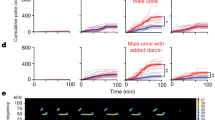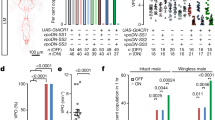Abstract
When two socially naive Drosophila males meet, they will fight. However, prior social grouping of males reduces their aggression. We found olfactory communication to be important for modulating Drosophila aggression. Although acute exposure to the male-specific pheromone 11-cis-vaccenyl acetate (cVA) elicited aggression through Or67d olfactory receptor neurons (ORNs), chronic cVA exposure reduced aggression through Or65a ORNs. Or65a ORNs were not acutely involved in aggression, but blockade of synaptic transmission of Or65a ORNs during social grouping or prior chronic cVA exposure eliminated social modulation of aggression. Artificial activation of Or65a ORNs by ectopic expression of the Drosophila gene TrpA1 was sufficient to reduce aggression. Social suppression of aggression requires subsets of local interneurons in the antennal lobe. Our results indicate that activation of Or65a ORNs is important for social modulation of male aggression, demonstrate that the acute and chronic effects of a single pheromone are mediated by two distinct types of ORNs, reveal a behaviorally important role for interneurons and suggest a chemical method to reduce aggression in animals.
This is a preview of subscription content, access via your institution
Access options
Subscribe to this journal
Receive 12 print issues and online access
$209.00 per year
only $17.42 per issue
Buy this article
- Purchase on Springer Link
- Instant access to full article PDF
Prices may be subject to local taxes which are calculated during checkout







Similar content being viewed by others
References
Sokolowski, M.B. Social interactions in “simple” model systems. Neuron 65, 780–794 (2010).
Rutter, M., Moffitt, T.E. & Caspi, A. Gene-environment interplay and psychopathology: multiple varieties but real effects. J. Child Psychol. Psychiatry 47, 226–261 (2006).
Cacioppo, J.T. & Hawkley, L.C. Perceived social isolation and cognition. Trends Cogn. Sci. 13, 447–454 (2009).
Fone, K.C. & Porkess, M.V. Behavioural and neurochemical effects of post-weaning social isolation in rodents: relevance to developmental neuropsychiatric disorders. Neurosci. Biobehav. Rev. 32, 1087–1102 (2008).
Valzelli, L. Effect of socio-environmental isolation on brain biochemistry, behaviour and psychoactive drug activity. Ann. Ist. Super. Sanita 14, 173–182 (1978).
Valzelli, L. The “isolation syndrome” in mice. Psychopharmacology (Berl.) 31, 305–320 (1973).
Rose, J.K., Sangha, S., Rai, S., Norman, K.R. & Rankin, C.H. Decreased sensory stimulation reduces behavioral responding, retards development, and alters neuronal connectivity in Caenorhabditis elegans. J. Neurosci. 25, 7159–7168 (2005).
Rai, S. & Rankin, C.H. Critical and sensitive periods for reversing the effects of mechanosensory deprivation on behavior, nervous system, and development in Caenorhabditis elegans. Dev. Neurobiol. 67, 1443–1456 (2007).
van der Goes van Naters, W. & Carlson, J.R. Receptors and neurons for fly odors in Drosophila. Curr. Biol. 17, 606–612 (2007).
Ronderos, D.S. & Smith, D.P. Activation of the T1 neuronal circuit is necessary and sufficient to induce sexually dimorphic mating behavior in Drosophila melanogaster. J. Neurosci. 30, 2595–2599 (2010).
Kurtovic, A., Widmer, A. & Dickson, B.J. A single class of olfactory neurons mediates behavioural responses to a Drosophila sex pheromone. Nature 446, 542–546 (2007).
Wang, L. & Anderson, D.J. Identification of an aggression-promoting pheromone and its receptor neurons in Drosophila. Nature 463, 227–231 (2010).
Veenema, A.H. Early life stress, the development of aggression and neuroendocrine and neurobiological correlates: what can we learn from animal models? Front. Neuroendocrinol. 30, 497–518 (2009).
Wang, L., Dankert, H., Perona, P. & Anderson, D.J. A common genetic target for environmental and heritable influences on aggressiveness in Drosophila. Proc. Natl. Acad. Sci. USA 105, 5657–5663 (2008).
Yurkovic, A., Wang, O., Basu, A.C. & Kravitz, E.A. Learning and memory associated with aggression in Drosophila melanogaster. Proc. Natl. Acad. Sci. USA 103, 17519–17524 (2006).
Svetec, N. & Ferveur, J.F. Social experience and pheromonal perception can change male-male interactions in Drosophila melanogaster. J. Exp. Biol. 208, 891–898 (2005).
Hoffmann, A.A. The influence of age and experience with conspecifics on territorial behavior in Drosophila melanogaster. J. Insect Behav. 3, 1–12 (1990).
Ha, T.S. & Smith, D.P. A pheromone receptor mediates 11-cis-vaccenyl acetate–induced responses in Drosophila. J. Neurosci. 26, 8727–8733 (2006).
Bartelt, R.J., Schaner, A.M. & Jackson, L.L. cis-Vaccenyl acetate as an aggregation pheromone in Drosophila melanogaster. J. Chem. Ecol. 11, 1747–1756 (1985).
Brieger, G. & Butterworth, F.M. Drosophila melanogaster: identity of male lipid in reproductive system. Science 167, 1262 (1970).
Getchell, T.V. & Shepherd, G.M. Adaptive properties of olfactory receptors analyzed with odor pulses of varying durations. J. Physiol. (Lond.) 282, 541–560 (1978).
Störtkuhl, K.F., Hovemann, B.T. & Carlson, J.R. Olfactory adaptation depends on the Trp Ca2+ channel in Drosophila. J. Neurosci. 19, 4839–4846 (1999).
Ayer, R.K. Jr. & Carlson, J. Olfactory physiology in the Drosophila antenna and maxillary palp: acj6 distinguishes two classes of odorant pathways. J. Neurobiol. 23, 965–982 (1992).
Tan, J., Savigner, A., Ma, M. & Luo, M. Odor information processing by the olfactory bulb analyzed in gene-targeted mice. Neuron 65, 912–926 (2010).
Ejima, A. et al. Generalization of courtship learning in Drosophila is mediated by cis-vaccenyl acetate. Curr. Biol. 17, 599–605 (2007).
Kitamoto, T. Conditional modification of behavior in Drosophila by targeted expression of a temperature-sensitive shibire allele in defined neurons. J. Neurobiol. 47, 81–92 (2001).
Han, D.D., Stein, D. & Stevens, L.M. Investigating the function of follicular subpopulations during Drosophila oogenesis through hormone-dependent enhancer-targeted cell ablation. Development 127, 573–583 (2000).
McGuire, S.E., Le, P.T., Osborn, A.J., Matsumoto, K. & Davis, R.L. Spatiotemporal rescue of memory dysfunction in Drosophila. Science 302, 1765–1768 (2003).
Hamada, F.N. et al. An internal thermal sensor controlling temperature preference in Drosophila. Nature 454, 217–220 (2008).
Jefferis, G.S. et al. Comprehensive maps of Drosophila higher olfactory centers: spatially segregated fruit and pheromone representation. Cell 128, 1187–1203 (2007).
Tanaka, N.K., Awasaki, T., Shimada, T. & Ito, K. Integration of chemosensory pathways in the Drosophila second-order olfactory centers. Curr. Biol. 14, 449–457 (2004).
Ruta, V. et al. A dimorphic pheromone circuit in Drosophila from sensory input to descending output. Nature 468, 686–690 (2010).
Chou, Y.H. et al. Diversity and wiring variability of olfactory local interneurons in the Drosophila antennal lobe. Nat. Neurosci. 13, 439–449 (2010).
Couto, A., Alenius, M. & Dickson, B.J. Molecular, anatomical, and functional organization of the Drosophila olfactory system. Curr. Biol. 15, 1535–1547 (2005).
Fishilevich, E. & Vosshall, L.B. Genetic and functional subdivision of the Drosophila antennal lobe. Curr. Biol. 15, 1548–1553 (2005).
Devaud, J.M., Acebes, A. & Ferrus, A. Odor exposure causes central adaptation and morphological changes in selected olfactory glomeruli in Drosophila. J. Neurosci. 21, 6274–6282 (2001).
Silbering, A.F. & Galizia, C.G. Processing of odor mixtures in the Drosophila antennal lobe reveals both global inhibition and glomerulus-specific interactions. J. Neurosci. 27, 11966–11977 (2007).
Root, C.M. et al. A presynaptic gain control mechanism fine-tunes olfactory behavior. Neuron 59, 311–321 (2008).
Datta, S.R. et al. The Drosophila pheromone cVA activates a sexually dimorphic neural circuit. Nature 452, 473–477 (2008).
Lin, H.H., Lai, J.S., Chin, A.L., Chen, Y.C. & Chiang, A.S. A map of olfactory representation in the Drosophila mushroom body. Cell 128, 1205–1217 (2007).
Kazama, H. & Wilson, R.I. Homeostatic matching and nonlinear amplification at identified central synapses. Neuron 58, 401–413 (2008).
Dierick, H.A. & Greenspan, R.J. Molecular analysis of flies selected for aggressive behavior. Nat. Genet. 38, 1023–1031 (2006).
Lieber, T., Kidd, S. & Struhl, G. DSL-Notch signaling in the Drosophila brain in response to olfactory stimulation. Neuron 69, 468–481 (2011).
Dacks, A.M., Green, D.S., Root, C.M., Nighorn, A.J. & Wang, J.W. Serotonin modulates olfactory processing in the antennal lobe of Drosophila. J. Neurogenet. 23, 366–377 (2009).
Zhou, C., Rao, Y. & Rao, Y. A subset of octopaminergic neurons are important for Drosophila aggression. Nat. Neurosci. 11, 1059–1067 (2008).
Ganguly-Fitzgerald, I., Donlea, J. & Shaw, P.J. Waking experience affects sleep need in Drosophila. Science 313, 1775–1781 (2006).
Fujii, S., Krishnan, P., Hardin, P. & Amrein, H. Nocturnal male sex drive in Drosophila. Curr. Biol. 17, 244–251 (2007).
Levine, J.D., Funes, P., Dowse, H.B. & Hall, J.C. Resetting the circadian clock by social experience in Drosophila melanogaster. Science 298, 2010–2012 (2002).
Chen, S., Lee, A.Y., Bowens, N.M., Huber, R. & Kravitz, E.A. Fighting fruit flies: a model system for the study of aggression. Proc. Natl. Acad. Sci. USA 99, 5664–5668 (2002).
Acknowledgements
We are grateful to B. Dickson (Research Institute of Molecular Pathology), P. Garrity (Brandeis University), T. Lee (Janelia Farm Research Campus), L. Luo (Stanford University), P. Shen (University of Georgia) and L. Vosshall (Rockefeller University) for providing stocks, W. Guo, C. Zhou and other members of the Rao laboratory for helpful discussions and technical assistance, and J. Tan and M. Luo for help with electrophysiology. This work was supported by the Ministry of Science and Technology (973 program No.2010CB833900).
Author information
Authors and Affiliations
Contributions
Y.R. conceived the project. Y.R., W.L. and X.L. designed the experiments. W.L. and X.L. performed the experiments. J.G. and Z.Y. synthesized cVA. Y.-H.Z. and J.-X.Z. performed the experiments shown in Supplementary Figure 1. W.L., X.L. and Y.R. wrote the paper.
Corresponding author
Ethics declarations
Competing interests
The authors declare no competing financial interests.
Supplementary information
Supplementary Text and Figures
Supplementary Figures 1–6 (PDF 2780 kb)
Rights and permissions
About this article
Cite this article
Liu, W., Liang, X., Gong, J. et al. Social regulation of aggression by pheromonal activation of Or65a olfactory neurons in Drosophila. Nat Neurosci 14, 896–902 (2011). https://doi.org/10.1038/nn.2836
Received:
Accepted:
Published:
Issue Date:
DOI: https://doi.org/10.1038/nn.2836
This article is cited by
-
Effects of lithium on aggression in Drosophila
Neuropsychopharmacology (2023)
-
Aggregation pheromones have a non-linear effect on oviposition behavior in Drosophila melanogaster
Nature Communications (2023)
-
A Neural Circuit Controlling Virgin Female Aggression Induced by Mating-related Cues in Drosophila
Neuroscience Bulletin (2023)
-
Social attraction in Drosophila is regulated by the mushroom body and serotonergic system
Nature Communications (2020)
-
The peacefulness gene promotes aggression in Drosophila
Molecular Brain (2019)



